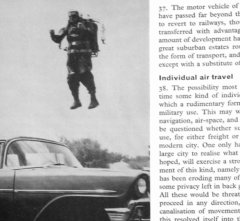
I just finished a term paper on “corridors in the polycentric city,” looking at various bodies of literature and their ideas for the urban form in transit corridors linking nodes in a city. Along the way, I read Stephen Marshall’s excellent Streets & Patterns, a well thought-out analysis of road hierarchies and the subtle auto-oriented biases they introduce. Marshall talked at great length about the Buchanan report (Traffic in Towns), a British government report from 1963.
The Buchanan report is an interesting beast. On the one hand, it documented all sorts of ills associated with the automobile in that era: parking everywhere, pedestrian injuries, derelict cars rusting in the middle of the city. On the other hand, the solution it proposed was to give the major street network over to cars entirely, labelling the main network “distributors.” It drew an analogy to a hospital: the rooms of the hospital (neighbourhoods bounded by distributors) are quiet, peaceful places; the corridors of the hospital are filled with food carts, stretchers and people moving everywhere. On the basis of this simplistic analogy, they recommended a similar treatment for cities. Is a city like a hospital, really? Should it be? Those questions went unasked. They also recommended rebuilding many major London streets with a pedestrian superstructure – rebuilding the outdoor pedestrian cafe experience one floor up on a system of walkways above the street. I’m glad that never happened.
The report was well aware of the coming storm: at the time of its writing, the majority of Britons did not yet own cars, but it was clear that the nation had but a few years left. Once the majority owned cars, it was clearly going to be difficult for a democratic government to limit their use.
But in its most entertaining content, the Buchanan report treats some very 1950s sci-fi ideas seriously, like personal jet propulsion:
The motor vehicle has been eroding most of the common amenities of life, but there is still some privacy left in back gardens, verandahs, bedrooms and on roof-tops. All these would be threatened if people could take off vertically at will.
Garden privacy is under threat!
I’ve been reading an insightful book called “Watching the English,” by sociologist Kate Fox. A large section is devoted to English attitudes toward privacy and, well, gardening.
In the argument, how does the automobile erode privacy – simply by the inaccessibility of your home? But presumably you’d still be on a road of some sort, maybe just one with less traffic.
b*
Interesting. I hadn’t really thought of the English having a distinctive approach to privacy.
It’s not the automobile that erodes privacy in this book – it’s personal jet propulsion, flying over others’ gardens.
oh, and one more entertaining note: the publisher of the book was Her Majesty’s Stationery Office. So incredibly English!
d
Yes and some of us don’t like the gradual abolition of the independent monarchy – we don’t like the new government by sociologists and bureaucrats.
HMSO is now called “Office of Public Sector Information” blaaaaaaaaaaaaaah… and we rarely see those envelopes that say “On Her Majesty’s Service” any more. Apparently none of the public services serve Her Majesty any more. Everyone serves either shareholders or, supposedly, the public, but in fact, little informed by public opinion but rather by the opinions of politicians and sociologists.